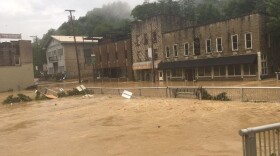As winter approaches, many eastern Kentuckians whose homes were hit by historic floods in July are still living out of travel trailers or in other unstable accommodations. Housing nonprofits in the region have worked to repair homes and build affordable and permanent housing. Leaders with those organizations say they are in dire need of more money and infrastructure improvements by the state.
The Housing Development Alliance (HDA) in Hazard and HOMES, Inc. in Whitesburg offer rebuilding and relocation assistance.
HDA currently serves the city of Hazard and Perry, Breathitt, Knott and Leslie counties, building affordable housing, providing homeowner and rental assistance.
Scott McReynolds, the Executive Director of the Housing Development Alliance, estimates the need for at least 2,300 new and rebuilt houses at a cost of more than $600 million.
“Money from the state is the need of the hour. Units are being built right now with charitable dollars, but what we really need is to know what’s coming, because houses don’t happen overnight. We’re out there trying to buy and develop lots, we’re working with families to fix their houses or relocate,” he said.
McReynolds said it’s frustrating that there isn’t a list of the exact number of families that don’t have homes.
“Everyday we see a family that has put a trailer back in the floodplain because that’s all the money they had. If the money is allocated, $50 million or not, then everybody at least knows what’s available. People can begin to plan. That’s what we really lost when we didn’t get money the first time round,” he said.
More than 13,000 people have applied for FEMA aid. State and federal officials have promised to get people into temporary housing while they search for long-term solutions, but this could take years.
Executive director of HOMES Inc. Seth Gold says there needs to be a push for better infrastructure in the next session.
“To build new houses away from the floodplain, there’s some really good places to be able to do that. But you can’t do that with all the water and sewage on the roads. That is money in a sense but it’s not directly tied to housing, it’s for infrastructure,” he said.
Advocates have brought up rental vouchers, but those also cost money, and require there to be enough houses to rent.
“Historically, we’ve had a broken housing market. There’s been very little housing development, and when the flood hit, we lost 25% of the housing here. We’ve been working hard on philanthropic dollars, but some people are still living couch to couch at this point,” he said.
In an interview with the Herald-Leader, Gov. Andy Beshear said there was a pending measure in Congress that could mean more money for the state to use for flood recovery. He acknowledged that permanent housing assistance would be the biggest challenge in the region.
In August, Beshear signed a flood relief package during a special session, providing $212.7 million for eastern Kentucky communities.
Both the governor and the GOP-led Legislature promised that the measure amounted to a temporary solution, and that more aid would be needed by the time lawmakers return for regular session in January 2023.
Hazard Republican Sen. Brandon Smith proposed an amendment to the bill, attempting to add $50 million for housing.
The measure didn’t make the final cut. GOP Senate President Robert Stivers, of Manchester, said that the Legislature would eventually take up more permanent solutions.
The relief package was largely paid for by the state’s budget reserve trust fund, sometimes called the “rainy day fund,” which has ballooned to $2.7 billion in recent years.






